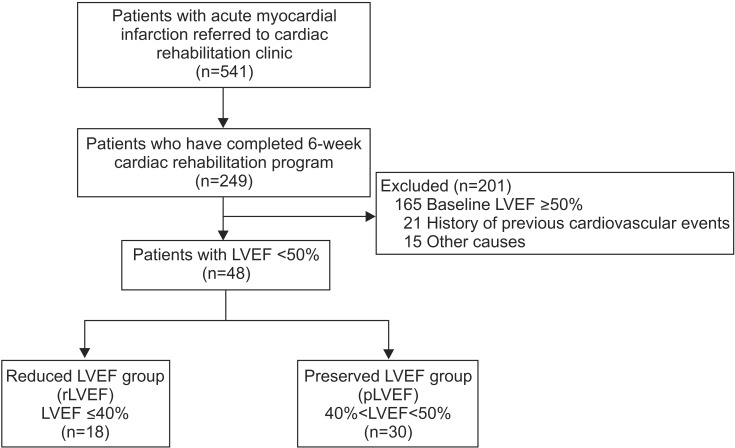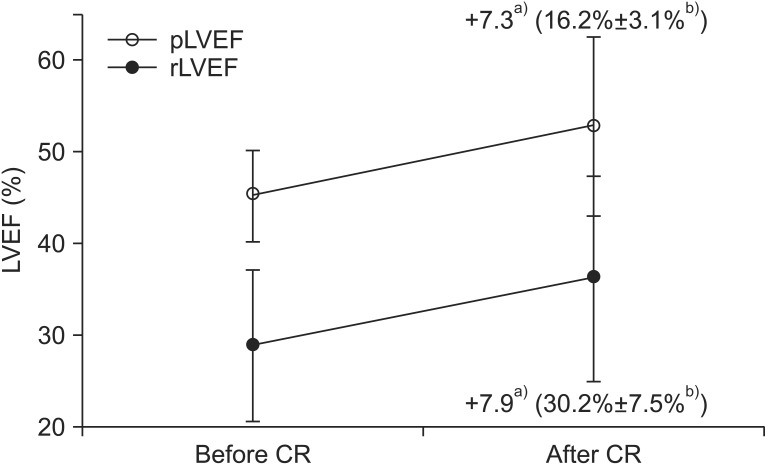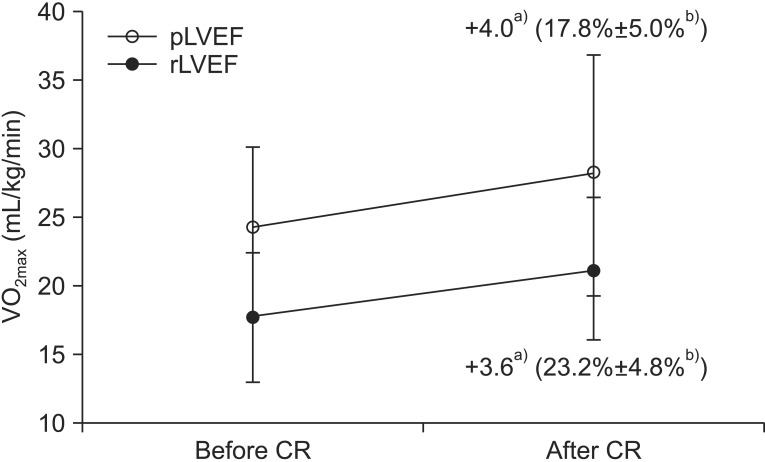Ann Rehabil Med.
2016 Aug;40(4):647-656. 10.5535/arm.2016.40.4.647.
The Effect of Cardiac Rehabilitation Exercise Training on Cardiopulmonary Function in Ischemic Cardiomyopathy With Reduced Left Ventricular Ejection Fraction
- Affiliations
-
- 1Department of Rehabilitation Medicine, Inje University Sanggye Paik Hospital, Inje University College of Medicine, Seoul, Korea. yjlim817@hanmail.net
- 2Department of Rehabilitation Medicine, Inje University Haeundae Paik Hospital, Inje University College of Medicine, Busan, Korea.
- KMID: 2356650
- DOI: http://doi.org/10.5535/arm.2016.40.4.647
Abstract
OBJECTIVE
To observe the effect and safety of cardiac rehabilitation (CR) exercise in ischemic cardiomyopathy and to compare the results between patients with preserved left ventricular ejection fraction (LVEF) and reduced LVEF.
METHODS
Patients with ischemic cardiomyopathy with LVEF <50% were included as subjects. The patients were classified into the preserved LVEF (pLVEF; LVEF 41%-49%) group and the reduced LVEF (rLVEF; LVEF ≤40%) group. Patients underwent hourly aerobic exercise training sessions with an intensity of 60%-85% of heart rate reserve, three times a week for 6 weeks. Graded exercise test and transthoracic echocardiogram were performed in all study patients before and after completion of the CR exercise program.
RESULTS
After completion of the CR exercise program, both groups (pLVEF, n=30; rLVEF, n=18) showed significant increases in LVEF and VO(2max). In the pLVEF group, LVEF and VO(2max) increased from 45.1%±4.8% to 52.5%±9.6% (p<0.001) and from 24.1±6.3 to 28.1±8.8 mL/kg/min (p=0.002), respectively. In the rLVEF group, LVEF and VO(2max) increased from 29.7%±7.7% to 37.6%±10.3% (p<0.001) and from 17.6±4.7 to 21.2±5.1 mL/kg/min (p<0.001), respectively. Both groups completed their exercise program safely.
CONCLUSION
In both groups, patients with ischemic cardiomyopathy who completed a 6-week supervised CR exercise program demonstrated remarkable improvements in cardiopulmonary function. This result implies that neither of the two groups showed higher efficacy in comparison to each other, but we can conclude that CR exercise in the rLVEF group was as effective and safe as that in the pLVEF group.
MeSH Terms
Figure
Reference
-
1. Hedback B, Perk J, Hornblad M, Ohlsson U. Cardiac rehabilitation after coronary artery bypass surgery: 10-year results on mortality, morbidity and readmissions to hospital. J Cardiovasc Risk. 2001; 8:153–158. PMID: 11455847.
Article2. Taylor RS, Brown A, Ebrahim S, Jolliffe J, Noorani H, Rees K, et al. Exercise-based rehabilitation for patients with coronary heart disease: systematic review and meta-analysis of randomized controlled trials. Am J Med. 2004; 116:682–692. PMID: 15121495.
Article3. O’Connor GT, Buring JE, Yusuf S, Goldhaber SZ, Olmstead EM, Paffenbarger RS, et al. An overview of randomized trials of rehabilitation with exercise after myocardial infarction. Circulation. 1989; 80:234–244. PMID: 2665973.
Article4. Dugmore LD, Tipson RJ, Phillips MH, et al. Changes in cardiorespiratory fitness, psychological wellbeing, quality of life, and vocational status following a 12 month cardiac exercise rehabilitation programme. Heart. 1999; 81:359–366. PMID: 10092561.5. Sutton MG, Sharpe N. Left ventricular remodeling after myocardial infarction: pathophysiology and therapy. Circulation. 2000; 101:2981–2988. PMID: 10869273.6. Dubach P, Myers J, Dziekan G, Goebbels U, Reinhart W, Vogt P, et al. Effect of exercise training on myocardial remodeling in patients with reduced left ventricular function after myocardial infarction: application of magnetic resonance imaging. Circulation. 1997; 95:2060–2067. PMID: 9133516.7. Ehsani AA, Biello D, Seals DR, Austin MB, Schultz J. The effect of left ventricular systolic function on maximal aerobic exercise capacity in asymptomatic patients with coronary artery disease. Circulation. 1984; 70:552–560. PMID: 6478561.
Article8. Weber KT, Kinasewitz GT, Janicki JS, Fishman AP. Oxygen utilization and ventilation during exercise in patients with chronic cardiac failure. Circulation. 1982; 65:1213–1223. PMID: 6804111.
Article9. Kramer N, Susmano A, Shekelle RB. The “false negative” treadmill exercise test and left ventricular dysfunction. Circulation. 1978; 57:763–768. PMID: 630685.
Article10. Benge W, Litchfield RL, Marcus ML. Exercise capacity in patients with severe left ventricular dysfunction. Circulation. 1980; 61:955–959. PMID: 6444854.
Article11. Port S, McEwan P, Cobb FR, Jones RH. Influence of resting left ventricular function on the left ventricular response to exercise in patients with coronary artery disease. Circulation. 1981; 63:856–863. PMID: 7471342.
Article12. Taylor RS, Davies EJ, Dalal HM, Davis R, Doherty P, Cooper C, et al. Effects of exercise training for heart failure with preserved ejection fraction: a systematic review and meta-analysis of comparative studies. Int J Cardiol. 2012; 162:6–13. PMID: 22664368.
Article13. Pandey A, Parashar A, Kumbhani DJ, Agarwal S, Garg J, Kitzman D, et al. Exercise training in patients with heart failure and preserved ejection fraction: meta-analysis of randomized control trials. Circ Heart Fail. 2015; 8:33–40. PMID: 25399909.14. Reibis R, Jannowitz C, Halle M, Pittrow D, Gitt A, Voller H. Management and outcomes of patients with reduced ejection fraction after acute myocardial infarction in cardiac rehabilitation centers. Curr Med Res Opin. 2015; 31:211–219. PMID: 25325219.
Article15. Yancy CW, Jessup M, Bozkurt B, Butler J, Casey DE Jr, Drazner MH, et al. 2013 ACCF/AHA guideline for the management of heart failure: a report of the American College of Cardiology Foundation/American Heart Association Task Force on Practice Guidelines. J Am Coll Cardiol. 2013; 62:e147–e239. PMID: 23747642.16. Wyer SJ, Earll L, Joseph S, Harrison J, Giles M, Johnston M. Increasing attendance at a cardiac rehabilitation programme: an intervention study using the Theory of Planned Behaviour. Coron Health Care. 2001; 5:154–159.
Article17. Bethell HJ. Exercise in cardiac rehabilitation. Br J Sports Med. 1999; 33:79–86. PMID: 10205687.
Article18. Beauchamp A, Worcester M, Ng A, Murphy B, Tatoulis J, Grigg L, et al. Attendance at cardiac rehabilitation is associated with lower all-cause mortality after 14 years of follow-up. Heart. 2013; 99:620–625. PMID: 23213175.19. Ali M, Qadir F, Javed S, Khan ZN, Asad S, Hanif B. Factors affecting outpatient cardiac rehabilitation attendance after acute myocardial infarction and coronary revascularization: a local experience. J Pak Med Assoc. 2012; 62:347–351. PMID: 22755278.20. Arthur HM, Suskin N, Bayley M, Fortin M, Howlett J, Heckman G, et al. The Canadian Heart Health Strategy and Action Plan: cardiac rehabilitation as an exemplar of chronic disease management. Can J Cardiol. 2010; 26:37–41. PMID: 20101356.
Article21. Lloyd-Jones DM, Hong Y, Labarthe D, Mozaffarian D, Appel LJ, Van Horn L, et al. Defining and setting national goals for cardiovascular health promotion and disease reduction: the American Heart Association’s strategic Impact Goal through 2020 and beyond. Circulation. 2010; 121:586–613. PMID: 20089546.22. Gaudron P, Eilles C, Kugler I, Ertl G. Progressive left ventricular dysfunction and remodeling after myocardial infarction: potential mechanisms and early predictors. Circulation. 1993; 87:755–763. PMID: 8443896.
Article23. Goldstein S, Sharov VG, Cook JM, Sabbah HN. Ventricular remodeling: insights from pharmacologic interventions with angiotensin-converting enzyme inhibitors. Mol Cell Biochem. 1995; 147:51–55. PMID: 7494555.
Article24. Pfeffer MA, Braunwald E. Ventricular remodeling after myocardial infarction: experimental observations and clinical implications. Circulation. 1990; 81:1161–1172. PMID: 2138525.
Article25. American Association of Cardiovascular and Pulmonary Rehabilitation. Guidelines for cardiac rehabilitation program. 2nd ed. Champaign: Human Kinetics;1995.26. Adamopoulos S, Coats AJ, Brunotte F, Arnolda L, Meyer T, Thompson CH, et al. Physical training improves skeletal muscle metabolism in patients with chronic heart failure. J Am Coll Cardiol. 1993; 21:1101–1106. PMID: 8459063.
Article27. Sullivan MJ, Higginbotham MB, Cobb FR. Exercise training in patients with severe left ventricular dysfunction: hemodynamic and metabolic effects. Circulation. 1988; 78:506–515. PMID: 3409495.
Article28. Hambrecht R, Niebauer J, Fiehn E, Kalberer B, Offner B, Hauer K, et al. Physical training in patients with stable chronic heart failure: effects on cardiorespiratory fitness and ultrastructural abnormalities of leg muscles. J Am Coll Cardiol. 1995; 25:1239–1249. PMID: 7722116.
Article29. Giannuzzi P, Tavazzi L, Temporelli PL, Corra U, Imparato A, Gattone M, et al. Long-term physical training and left ventricular remodeling after anterior myocardial infarction: results of the Exercise in Anterior Myocardial Infarction (EAMI) trial. EAMI Study Group. J Am Coll Cardiol. 1993; 22:1821–1829. PMID: 8245335.30. Jette M, Heller R, Landry F, Blumchen G. Randomized 4-week exercise program in patients with impaired left ventricular function. Circulation. 1991; 84:1561–1567. PMID: 1914097.
Article31. Haykowsky M, Scott J, Esch B, Schopflocher D, Myers J, Paterson I, et al. A meta-analysis of the effects of exercise training on left ventricular remodeling following myocardial infarction: start early and go longer for greatest exercise benefits on remodeling. Trials. 2011; 12:92. PMID: 21463531.
Article32. Chen YM, Li ZB, Zhu M, Cao YM. Effects of exercise training on left ventricular remodelling in heart failure patients: an updated meta-analysis of randomised controlled trials. Int J Clin Pract. 2012; 66:782–791. PMID: 22805270.
Article33. Lee BC, Chen SY, Hsu HC, Su MY, Wu YW, Chien KL, et al. Effect of cardiac rehabilitation on myocardial perfusion reserve in postinfarction patients. Am J Cardiol. 2008; 101:1395–1402. PMID: 18471448.
Article34. Linxue L, Nohara R, Makita S, Hosokawa R, Hata T, Okuda K, et al. Effect of long-term exercise training on regional myocardial perfusion changes in patients with coronary artery disease. Jpn Circ J. 1999; 63:73–78. PMID: 10084367.
Article35. Makaryus J, Tobe L, Alharbi M, Kim D, Ershova S, Robi A, et al. Cardiac rehabilitation improves myocardial blood flow reserve as assessed by positron emission tomographic myocardial perfusion imaging. J Am Coll Cardiol. 2014; 63(12 Suppl):A1017.
Article36. Lee BC, Hsu HC, Tseng WY, Su MY, Chen SY, Wu YW, et al. Effect of cardiac rehabilitation on angiogenic cytokines in postinfarction patients. Heart. 2009; 95:1012–1018. PMID: 19304668.
Article37. Nishi I, Noguchi T, Iwanaga Y, Furuichi S, Aihara N, Takaki H, et al. Effects of exercise training in patients with chronic heart failure and advanced left ventricular systolic dysfunction receiving β-blockers. Circ J. 2011; 75:1649–1655. PMID: 21613745.
- Full Text Links
- Actions
-
Cited
- CITED
-
- Close
- Share
- Similar articles
-
- Differential Diagnosis between Dilated Cardiomyopathy and Ischemic Heart Failure with Post-Exercise Echocardiography
- Evaluation of Ejection Fraction Obtained by Echocardiography and Radionuclide Ventriculography
- Cardiac Rehabilitation of Heart Failure
- Radionuclide Assessment of Cardiac Performance in Dilated Cardiomyopathy
- The Evaluation of Cardiac Function in Duchenne Muscular Dystrophy




